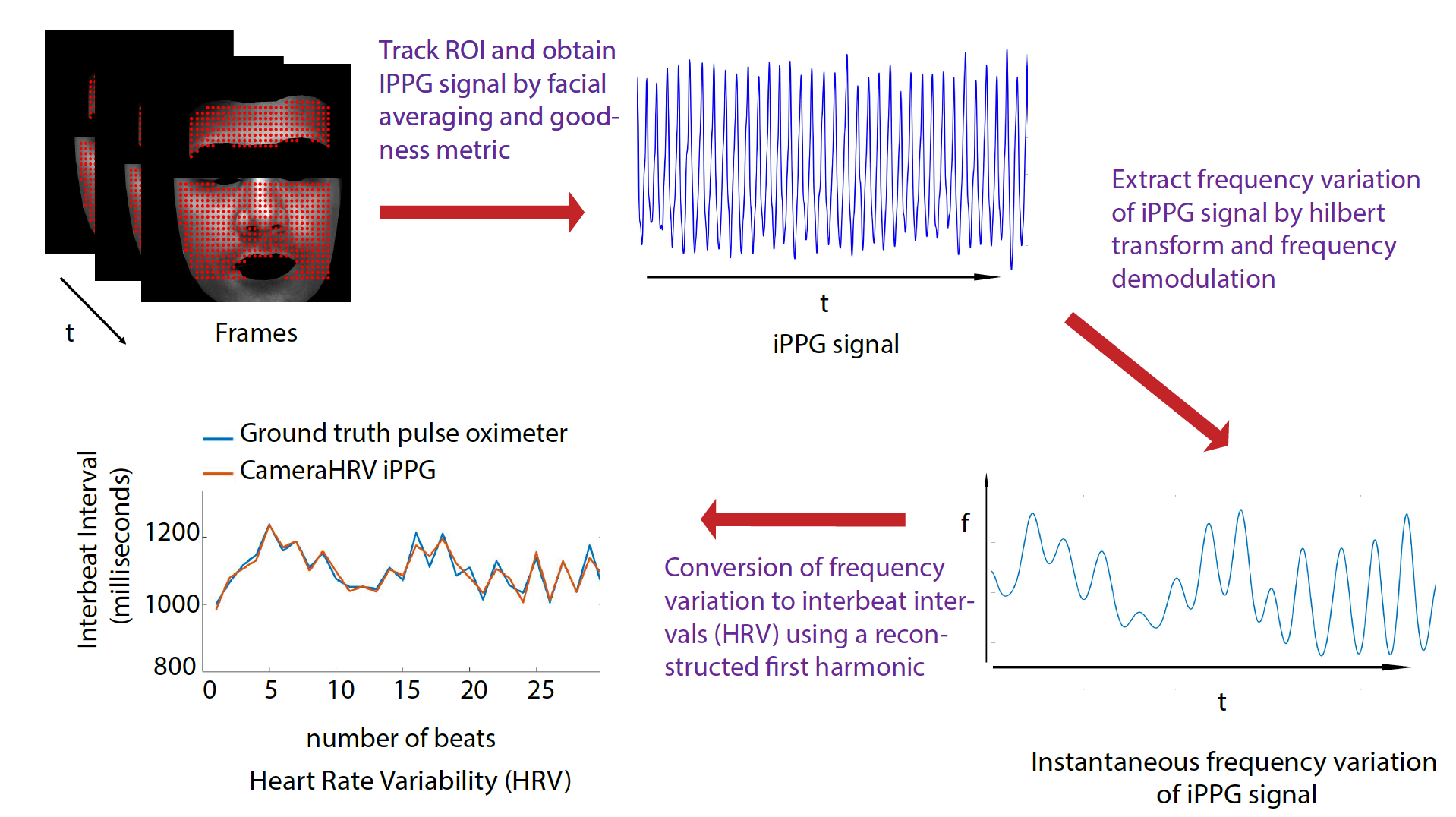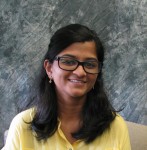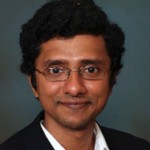CameraHRV
Overview: A Robust method to extract HRV using a camera
The inter-beat-interval (the time period of the cardiac cycle) changes slightly for every heartbeat; this variation is measured as Heart Rate Variability (HRV). HRV is presumed to occur due to interactions between the parasympathetic and sympathetic nervous system. Therefore, it is sometimes used as an indicator of the stress level of an individual. HRV also reveals some clinical information about cardiac health.
New Dataset – relevant for distancePPG, PulseCam and CameraHRV – see information below
CameraHRV: Robust measurement of heart rate variability using a camera

The Problem:
Currently, HRV is accurately measured using contact devices such as a pulse oximeter. However, recent research in the field of non-contact imaging Photoplethysmography (iPPG) has made vital sign measurements using just the video recording of any exposed skin (such as a person’s face) possible. The current signal processing methods for extracting HRV using peak detection perform well for contact-based systems but have poor performance for the iPPG signals. The main reason for this poor performance is the fact that current methods are sensitive to large noise sources which are often present in iPPG data. Further, current methods are not robust to motion artifacts that are common in iPPG systems.
Our Solution:
We developed a new algorithm, CameraHRV, for robustly extracting HRV even in low SNR such as is common with iPPG recordings. CameraHRV combined spatial combination and frequency demodulation to obtain HRV from the instantaneous frequency of the iPPG signal. CameraHRV outperforms other current methods of HRV estimation. Ground truth data was obtained from FDA-approved pulse oximeter for validation purposes. CameraHRV on iPPG data showed an error of 6 milliseconds for low motion and varying skin tone scenarios. The improvement in error was 14%. In case of high motion scenarios like reading, watching and talking, the error was 10 milliseconds.
Dataset:
This was not the dataset used in the paper, as the original paper dataset did not have consent from participants to share the data. We have collected a new dataset, with proper consent.
Imaging Photoplethysmography Dataset
Main Purpose: Extracting heart rate and heart rate variability(HRV) from imaging Photoplethysmography signals acquired using cameras has been an advancing area of research. Non-contact or remote measurement of HRV has many potential applications such as stress or fatigue monitoring at the workplace as well as early detection of autonomic cardiac neuropathy. As measuring HRV during different activities such as deep breathing and engagement is of interest, we collected a unique dataset that provides researchers the resources to investigate non-contact iPPG based HRV and HR measurements. Since the dataset consists of activities with complex facial movement, researchers can use it to develop iPPG algorithms that are robust to such high facial motion scenarios The dataset consists of facial video recordings of 12 subjects (8 male, six female) under different engagement activities such as reading a webpage, talking about their day, watching a movie trailer and deep breathing. It also contains videos when they were stationary to establish a baseline. The video for each activity is 2 minutes. Ground truth PPG data were collected simultaneously using an FDA approved pulse oximeter. The experiment setup details are:
Camera: Serial number-17473548
Camera model: Blackfly BFLY-U3-23S6C
Camera vendor: Point Grey Research
Sensor: Sony IMX249 (1/1.2″ Color CMOS)
Resolution: 1920×1200
Illumination: White LED flood lights, battery powered
Pulse Oximeter:CMS 50D+ pulse oximeter
Acquisition software: Custom software for synchronized collection of camera frames and pulse oximeter PPG waveform data
Data collection Protocol: IRB consent form signed
- 2 min video recording stationary with normal breathing
- 2 min video recording reading a webpage about funny facts
- 2 min video recording watching an informative video
- 2 min video recording of talking
- 2 min video deep breathing exercise. (inhalation for 6 seconds and exhalation for 5 seconds)
Any use of the dataset needs to cite the following two publications:
1) Pai, Amruta. “HRVCam: Measuring Heart Rate Variability With A Camera.” (2018) Master’s Thesis, Rice University. http://hdl.handle.net/1911/105898.
2) Amruta Pai, Ashok Veeraraghavan, and Ashutosh Sabharwal, CameraHRV: Robust measurement of heart rate variability using a camera. SPIE BIOS (2018)
Team

Amruta Pai
Graduate Student, ECE
Rice University

Dr. Ashok Veeraraghavan
Associate Professor
ECE, Rice University

Dr. Ashutosh Sabharwal,
Professor
ECE, Rice University
Paper
Amruta Pai, Ashok Veeraraghavan, and Ashutosh Sabharwal, CameraHRV: Robust measurement of heart rate variability using a camera. SPIE BIOS (2018)
